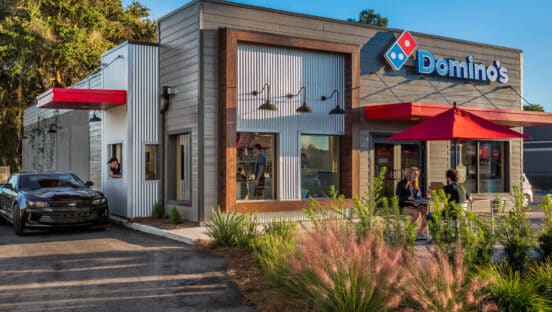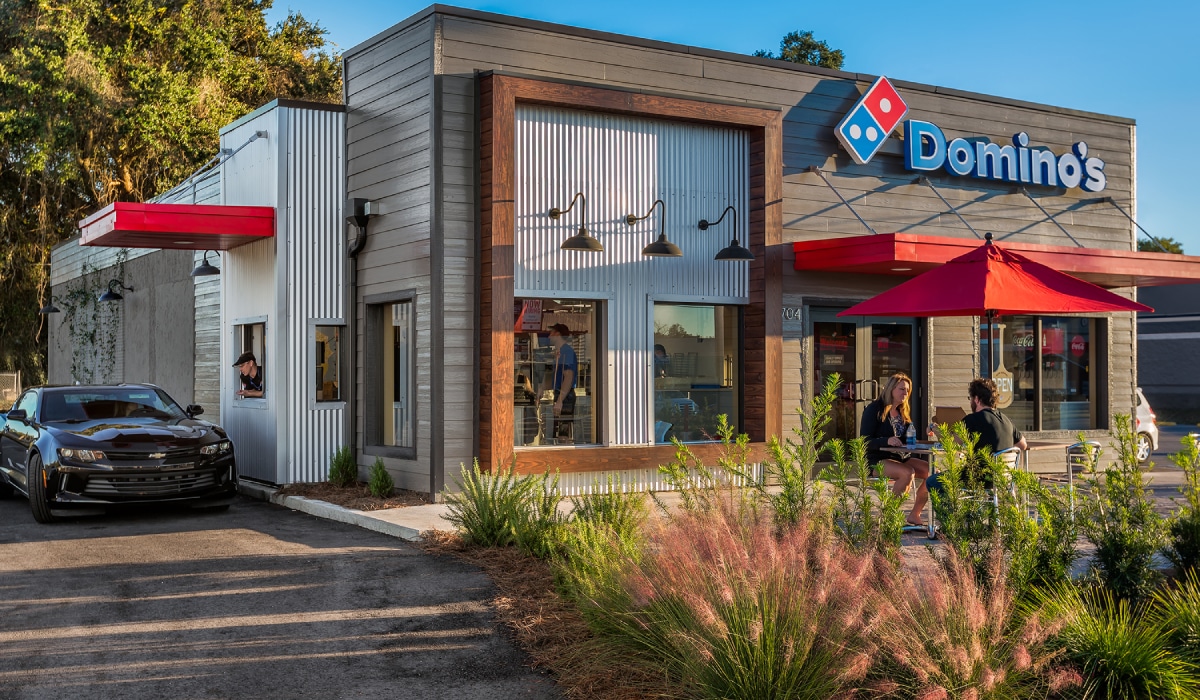Similar to its customer base, Domino’s executives are hungry.
For the pizza chain, that doesn’t mean a bodily reaction. It’s a prevailing framework the brand will use to attack the next five years as it attempts to recover from sliding sales, inflation, and degradation of delivery. The plan is officially called “Hungry for More,” with the final word serving as a key acronym: Most Delicious Food, Operational Excellence, Renowned Value, and Enhanced by Best-in-Class Franchisees.
The company is confident enough in the strategy that it completely retooled its five-year guidance and removed estimated ranges to hold itself more accountable. To start, annual global retail sales growth from 2024–2028 was bumped from 4–8 to 7 percent. That would be more than $7 billion in incremental sales during those five years, $3 billion of which would come from the U.S. segment. The retail sales expansion assumes 3 percent annual same-store sales increases domestically and internationally.
The annual global net unit growth target increased from 5–7 percent to 1,100 net stores, or 5,500 across five years—close to Domino’s systemwide count in 2017. In the U.S. specifically, Domino’s has about 6,800 stores and expects that to reach roughly 7,700-plus by 2028 and 8,500-plus in the longer term. On the international side, the brand projects that it will go from approximately 13,400 locations to 18,500-plus in 2028 and 40,000-plus in the longer term. Combine those two business segments and Domino’s believes it has whitespace for close to 50,000 restaurants globally.
At the same time, Domino’s wants to put more money in the hands of franchisees. The chain forecasts 8 percent annual operating income growth in the next five years, which would be an additional $400 million. U.S. franchisees earned $139,000 in average EBITDA per unit in 2022. This year, it’s estimated to be $160,000. Domino’s is targeting more than $170,000 in 2024.
READ MORE:
Domino’s Confidence Isn’t Shaking Amid Slower Sales
Domino’s Strives for $2 Billion Carryout Opportunity
Domino’s Wants Customers to Know it’s Obsessed with Delivery
For Domino’s to witness all those gains, it’ll start with food. Weiner said the brand talks in length about technology and value, but it hasn’t “romanced our product the way we know that we can.” The chain plans to take that up a notch through marketing, better food photography, and menu innovation. This has already been put into action. In 2023, Domino’s launched two menu innovations in the same year for the first time since 2011—Pepperoni Stuffed Cheesy Bread and Loaded Tots. Weiner said some “menu renovation” would take place as well, similar to how the company upgraded its pizzas more than a decade ago.
“There’s no freezers in our stores, no fryers in our stores,” Joe Jordan, president of the U.S. business and global services, told investors Wednesday. “Everything’s made fresh to order. We’re really proud of the food that comes out of a Domino’s store.”
Additionally, Domino’s is changing how it makes these enhanced food items thanks to DomOs, the chain’s proprietary technology that orchestrates back-of-house processes. For example, when a customer builds a pizza, the system tells employees to make it before the order is completed online. Also, the brand is adding automation to its make line by introducing “DJ,” a robotic dough stretcher. It teaches workers how to stretch dough to Domino’s specifications in two days versus 26. This dough is then placed into an oven that’s two minutes faster the the chain’s traditional equipment. And when the pizza comes out, boxes are ready to go instead of employees being bogged down by having to fold them into space. To complete everything, orders are bagged and transported directly to a driver who doesn’t have to leave their vehicle. DomOs is connected to every driver and alerts restaurants when they are approaching.
Externally, the company is working with Microsoft to develop a generative AI component intended to streamline store operations and customer ordering.
Value is the third piece, but beyond favorable price points. In some cases, there could be more options, which is why the brand decided to join the Uber Eats marketplace, a venture that could lead to $1 billion in incremental sales. Value is connected to the loyalty program too. The chain recently lowered the spending threshold to earn rewards points from $10 to $5, which is better for guests who enjoy purchasing the everyday $7.99 carryout deal. Also, customers are eligible to redeem quicker, with tiers of 20, 40, and 60.
Guests can also expect greater personalization, like dynamic offers, rewards, and menu items that cater to an individual’s profile. This will be pulled from years of data gathering on web/app platforms. Domino’s has experienced 15 straight years of digital sales increases and earned more than $7.5 billion in the trailing 12 months ending in Q3. Overall, these channels mix 85 percent. The company is in the process of revamping its website and mobile app with optimization for delivery and carryout, streamlined navigation, and faster performance. Elements will be placed onto the platforms periodically and should be finished by the end of 2024.
Franchisees are the fourth and final part. Domino’s has about 730 U.S. operators that own nine stores on average. The typical payback on those restaurants is about three years, a point of attraction the brand has maintained throughout the pandemic. The company’s future is backed by a pipeline of more than 170 potential new franchisees. Of that, 50 are ready to open a store. Outside of the U.S., Domino’s is 100 percent franchised across 93 markets. These stores are operated by 46 master franchisees, including seven public companies. They’ve all worked to deliver 30 straight years of same-store sales growth.
“We get the next generation of franchisees really excited,” Weiner said. “We say this all the time. You can’t become a franchisee at Domino’s Pizza unless you work at Domino’s. Since I’ve been here in 15 years, [we’ve] never had more people in our franchise management school, and we’ve never had more people finished with it ready to sign and open a new store. Our franchisees and our future franchisees are really excited about what we’re delivering.”
U.S. same-store sales declined 0.6 percent in Q3, after lifting just 0.1 percent in the second quarter. The decrease was driven by order count declines, partially offset by a higher average ticket thanks to an average price jump of 3.2 percent. The brand opened 28 domestic locations and closed one, pushing the footprint to 6,762 outlets as of September 10. Seventy-two units are under construction, and most of them should open in the fourth quarter.









